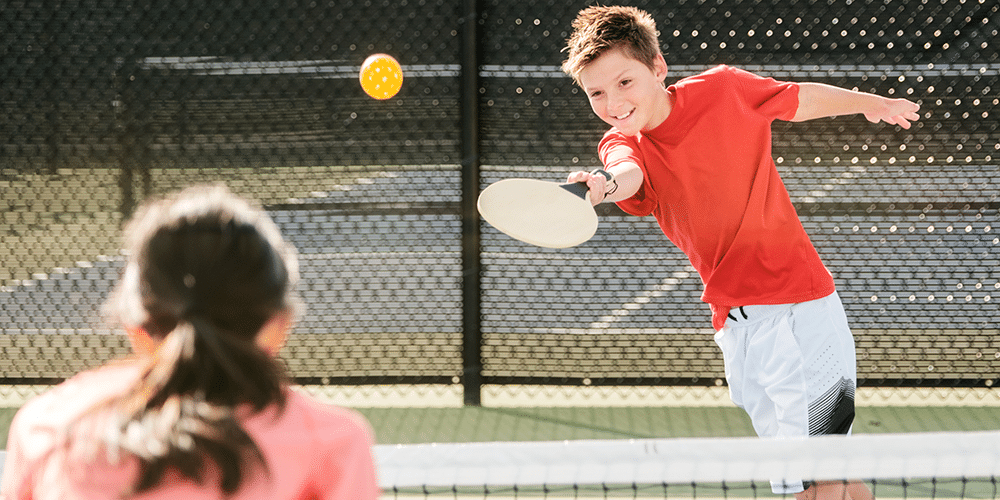Ready to play pickleball? By now, you’re probably aware that we’re in the midst of something like a pickleball craze. What was once considered a niche game for boomers and retirees is now sweeping up just about everyone. News organizations are covering the rise of pickleball. Sports Illustrated even wrote a piece chronicling the controversial side of the sport.
Whether you’ve picked up a pickleball paddle or not, it’s time to learn more about this rapidly-growing sport. Let’s dive into some of the basics of the game, find out where and how people are playing, and get you ready to hit the pickleball court!
What Is Pickleball?
Pickleball is a racket sport that resembles tennis and ping pong. It is played on a court with a similar layout to a tennis court, although the dimensions are smaller. Players hit the ball back and forth over a net, scoring points when their opponent is unable to return the ball.
The game was invented relatively recently, in 1965, by three dads from Washington State who were looking for a way to entertain their kids on a lazy summer weekend. It may or may not be named after a dog called Pickles.
The world’s first pickleball tournament was played in 1976, and the United States Amateur Pickleball Association (USAPA) was formed in 1984. But the sport remained fairly obscure until recently. According to the Sports & Fitness Industry Association (SFIA), participation in the sport has grown by 158% over the past three years (with the highest growth rate found in Midwest states). The Association of Pickleball Players estimates that the sport now has more than 36 million participants.
Why Is Pickleball So Popular?
Pickleball has exploded in popularity for many reasons. For one, the sport is easy to learn and relatively simple to play, even for beginners. It’s an active sport, but people of all fitness levels can participate. It’s also a multi-generational sport, bringing together everyone from Boomers to Gen Z.
Pickleball really began its rise during the pandemic, when many people were seeking outdoor, social activities to participate in. Parks began opening new pickleball courts (or converting tennis courts for pickleball use). Oh, and a little TikTok exposure didn’t hurt. Pickleball videos have more than 1 billion views on the platform.
Where to Play Pickleball?
Pickleball is a versatile sport that can be played on indoor or outdoor courts. The USA Pickleball says there are now approximately 44,000 pickleball courts across the country. Many neighborhood and public parks have installed pickleball courts — you’ll find them everywhere, from Spearfish City Park in South Dakota to Riverfront Park in Riverside, Missouri, to Evergreen Park in Roseville, Minnesota.
The best way to find publicly available courts near you is to search a reputable database like Pickleheads or download an app like PicklePlay. Or you could just take a walk or drive to a local park — you’re bound to run into a court since they’re practically everywhere these days!
If the weather isn’t cooperating or you just prefer an indoor court, there are plenty of those around, too. While national fitness chains like 24-Hour Fitness have been slow to jump on the trend, many local gyms, like the Ames Fitness Center — have their own courts. Many YMCAs also offer courts, as do university gyms like Hyslop Sports Center at UND and the Nicholas Recreation Center at UW.
Get Geared Up
So, what do you need to play pickleball? Not much, which is another big reason the sport is growing so quickly. The most important thing is a pickleball paddle. These paddles are larger than ping pong paddles but smaller than tennis rackets. The official rules limit the combined length and width of a paddle to 24 inches.
Most pickleball paddles are made of graphite or fiberglass, although you can find aluminum paddles as well. Just about any sporting goods store is likely to carry an array of different paddles for sale. Which type is best? It’s really a personal choice, so you won’t know until you get out and try one on the court!
Perhaps it’s obvious, but you’ll also need a few pickleball balls to play! These balls resemble wiffle balls, although they are slightly heavier. Do note that indoor and outdoor pickleball balls have minor differences — outdoor balls are usually a bit heavier and have smaller holes to combat the impact of the wind.
Rules of the Game
The basic rules of pickleball are quite simple and are similar to other net sports. Players (or teams of two) are positioned on opposite sides of the net. Each point begins with an underhand serve, and players hit the ball back and forth until a fault occurs. A fault happens when a shot is hit out of bounds, into the net, or can’t be returned.
Like table tennis, points can only be scored by the serving team. If you serve and your opponent faults, you score a point. If you serve and then you fault, it’s now your opponent’s turn to serve. The first side to score 11 points wins, although you must win by two.
Those are the very basics. Like any great game, pickleball also has some idiosyncrasies. For example, the “double bounce” rule means that serves must bounce before they can be returned, and the same is true for the next shot. When you hit the ball without allowing it to bounce, that is known as a volley. Volleys are generally permissible, although there is an area closer to the net where no volleys are allowed. This area is sometimes known as the “kitchen” (no word on whether this is also named after a dog).
The game is set up for maximum enjoyment and participation. The “double bounce” rule ensures that each point gets off to a fair start. And the “kitchen” zone prevents players from just camping at the net and spiking the ball. It’s no wonder the game is popular among such a wide variety of players.
Pickle Your Fancy?
Now that you know the how, where, and why, it’s time to hit the courts! You’re ready to participate in the phenomenon that is pickleball. Just make sure you have someone filming the game so the highlights can go straight to TikTok.
Related Articles
- Bicycle Across Iowa This Summer
- Kansas State Sports: A Quick and Dirty Guide
- Iowa State Football: A Season to Rebound
- The Craziest Rivalries in Midwest University Sports
- The Most Popular Midwest Sports
- Don’t Do Submarines, Skydive the Midwest Instead
###


